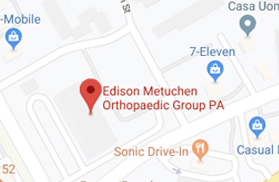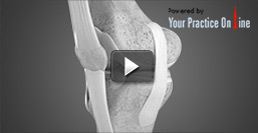Knee
Normal Anatomy of the Knee Joint
The knee is made up of four bones. The femur or thighbone is the bone connecting the hip to the knee. The tibia or shinbone connects the knee to the ankle. The patella (kneecap) is the small bone in front of the knee and rides on the knee joint as the knee bends. The fibula is a shorter and thinner bone running parallel to the tibia on its outside. The joint acts like a hinge but with some rotation.
Find out more about Normal Anatomy of the Knee Joint with the following links
Knee Fracture
A fracture is a condition in which there is break in the continuity of the bone. In younger individuals these fractures are caused from high energy injuries, as from a motor vehicle accident. In older people the most common cause is weak and fragile bone.
Find out more about Knee Fracture with the following link
Meniscus Tear
Meniscus tear is the commonest knee injury in athletes, especially those involved in contact sports. A suddenly bend or twist in your knee cause the meniscus to tear. This is a traumatic meniscus tear.
Find out more about Meniscus Tear with the following links
Patellofemoral Instability
The knee can be divided into three compartments: patellofemoral, medial and lateral compartment. The patellofemoral compartment is the compartment in the front of the knee between the knee cap and thigh bone.
Find out more about Patellofemoral Instability with the following links
Arthroscopy of the Knee Joint
Knee Arthroscopy is a common surgical procedure performed using an arthroscope, a viewing instrument, to look into the knee joint to diagnose or treat a knee problem. It is a relatively safe procedure and a majority of the patient’s discharge from the hospital on the same day of surgery.
Find out more about Arthroscopy of the Knee Joint with the following links
Anterior Cruciate Ligament ACL Reconstruction
The anterior cruciate ligament is one of the major stabilizing ligaments in the knee. It is a strong rope like structure located in the center of the knee running from the femur to the tibia.
Find out more about Anterior Cruciate Ligament ACL Reconstruction with the following link
ACL Reconstruction Patellar Tendon
Anterior cruciate ligament (ACL) reconstruction patellar tendon is a surgical procedure that replaces the injured ACL with a patellar tendon. Anterior cruciate ligament is one of the four major ligaments of the knee that connects the femur (thigh bone) to the tibia (shin bone) and helps stabilize the knee joint. Anterior cruciate ligament prevents excessive forward movement of the lower leg bone (tibia) in relation to the thigh bone (femur) as well as limits rotational movements of the knee.
Find out more about ACL Reconstruction Patellar Tendon with the following links
ACL Reconstruction Hamstring Tendon
Anterior cruciate ligament (ACL) reconstruction hamstring method is a surgical procedure that replaces the injured ACL with a hamstring tendon. Anterior cruciate ligament is one of the four major ligaments of the knee that connects the femur (thigh bone) to the tibia (shin bone) and helps stabilize your knee joint. Anterior cruciate ligament prevents excessive forward movement of the lower leg bone (the tibia) in relation to the thigh bone (the femur) as well as limits rotational movements of the knee.
Find out more about ACL Reconstruction Hamstring Tendon with the following links
Uni condylar Knee Replacement
Unicompartmental knee replacement is a minimally invasive surgery in which only the damaged compartment of the knee is replaced with an implant. It is also called a partial knee replacement. The knee can be divided into three compartments: patellofemoral, the compartment in front of the knee between the knee cap and thigh bone, medial compartment, on the inside portion of the knee, and lateral compartment which is the area on the outside portion of the knee joint.
Find out more about Uni condylar Knee Replacement with the following links
Click on the topics below to find out more from the orthopedic connection website of American Academy of Orthopaedic Surgeons.
- ACL Injury: Should it be fixed?
- Activities After a Knee Replacement
- Additional Resources on the Knee
- Adolescent Anterior Knee Pain
- Arthritis of the Knee
- Care of the Aging Knee: Baby Boomers May Need Lifestyle Changes
- Cemented and Cementless Knee Replacement
- Deep Vein Thrombosis
- Frequently Asked Questions about Osteoarthritis of the Knee
- Goosefoot (Pes Anserine) Bursitis of the Knee
- Knee Arthroscopy
- Knee Arthroscopy Exercise Guide
- Knee Implants
- Knee Replacement Exercise Guide
- Kneecap (Prepatellar) Bursitis
- Meniscal Tear
- Meniscal Transplants
- Minimally Invasive Total Knee Replacement
- Nonsurgical Treatment Options for Osteoarthritis of the Knee
- Orthopaedists Research Female Knee Problems
- Osgood-Schlatter Disease (Knee Pain)
- Osteonecrosis of the Knee
- Posterior Cruciate Ligament (PCL) Tear
- Rotating Platform/Mobile-bearing Knees
- Runner’s Knee (Patellofemoral Pain)
- Surgical Treatment of Osteoarthritis of the Knee
- The Knee
- Total Knee Replacement
- Unstable Kneecap
- Viscosupplementation Treatment for Arthritis
 Menu
Menu






